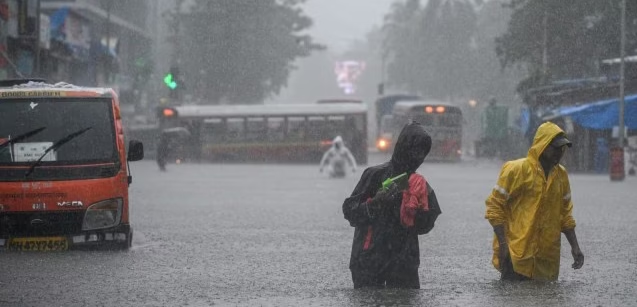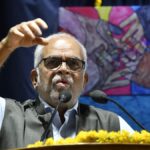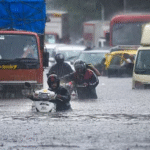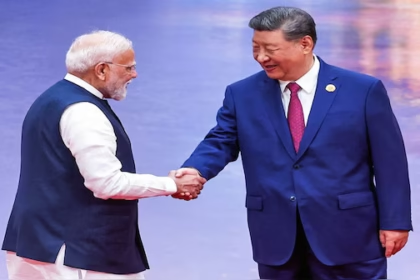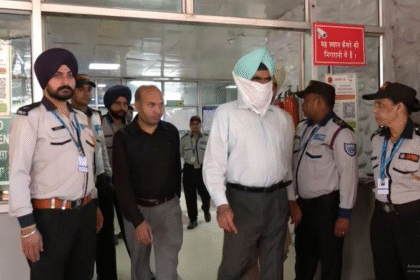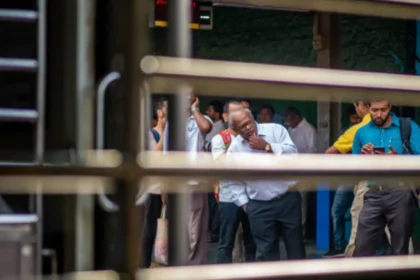Mumbai Weather Today Live Updates: Heavy Rains, Traffic, and Waterlogging
Mumbai, the financial capital of India, is once again facing the fury of relentless monsoon rains. The city, known for its resilience during extreme weather, is currently witnessing widespread waterlogging, traffic snarls, train disruptions, and warnings from the India Meteorological Department (IMD). For Mumbaikars, heavy rains are not new, but the scale and intensity of this year’s downpour have raised fresh concerns about preparedness, infrastructure, and the daily struggles of millions who rely on the city’s transport and civic systems.
The IMD has issued multiple warnings for Mumbai and its adjoining regions, predicting heavy to very heavy rainfall in isolated pockets. In some areas, the intensity of rainfall has crossed 100 mm within hours, leading to flooding on roads, railway tracks, and low-lying neighborhoods. Visuals from across the city show vehicles stranded in knee-deep waters, commuters wading through flooded streets, and residents struggling to keep water from entering their homes.
Public transportation, which is the lifeline of Mumbai, has been severely impacted. Suburban trains, often called the city’s heartbeat, are running late, with some services suspended due to track inundation. BEST buses have been diverted from their usual routes, and flight operations at Chhatrapati Shivaji Maharaj International Airport have also faced disruptions, with several flights delayed or diverted due to poor visibility and slippery runways.
Traffic congestion has reached alarming levels as major roads, including the Eastern Express Highway, Western Express Highway, and key arterial routes, are clogged with vehicles. The city’s famed local trains are overcrowded with stranded passengers, many of whom have been waiting for hours to reach their destinations. Ride-hailing services are charging surge prices, adding to the woes of daily commuters.
Schools and colleges in some districts have been instructed to remain closed, prioritizing the safety of children. The Brihanmumbai Municipal Corporation (BMC) has also deployed additional teams with water pumps, disaster response vehicles, and emergency control rooms to monitor the situation. Officials have urged citizens to stay indoors unless absolutely necessary, warning that more heavy showers are expected in the coming days.
Beyond transportation and civic life, the rains are also impacting health and safety. Waterlogging often leads to outbreaks of vector-borne diseases such as malaria and dengue, as well as water-borne infections. Authorities are on high alert, distributing medicines and conducting awareness campaigns to prevent an outbreak.
For Mumbaikars, this is not just about inconvenience—it is about resilience. The city has a long history of battling extreme weather, from the floods of 2005 to subsequent monsoon seasons that tested its limits. Yet, each year, questions arise about whether enough has been done to upgrade the drainage system, improve infrastructure, and create sustainable solutions for climate change-induced rainfall patterns.
This ongoing weather crisis is a reminder that Mumbai’s fight against the monsoon is not just about surviving a season, but about rethinking urban planning, disaster preparedness, and the balance between development and sustainability.
As the downpour continues, Mumbai’s civic administration finds itself in the spotlight once again. The Brihanmumbai Municipal Corporation (BMC), India’s richest civic body, has been working round the clock to manage the crisis. Despite years of investment in stormwater drains, pumping stations, and flood-mitigation projects, the annual monsoon still exposes the vulnerabilities of the city’s infrastructure. Critics argue that much of the problem lies in unplanned urbanization, encroachment on natural water bodies, and the city’s limited drainage capacity.
Several low-lying areas such as Sion, Kurla, Andheri Subway, Hindmata, and parts of Dadar were among the worst affected, with water rising to levels that made movement nearly impossible. Social media platforms were flooded with videos of vehicles submerged up to their windshields, while pedestrians formed human chains to navigate through waterlogged roads. The visuals serve as stark reminders of the gap between promises of a “monsoon-ready Mumbai” and the ground reality faced by its residents.
The railway network, often described as Mumbai’s lifeline, is bearing the brunt of the rains. Services on the Central and Western lines have been delayed by over 30 minutes to an hour, with several trains canceled due to tracks being submerged in rainwater. The Harbour line has also faced intermittent disruptions, leaving thousands of commuters stranded on platforms. Passengers have expressed frustration, with many criticizing the lack of timely updates and alternative arrangements. For daily wage workers, such disruptions are more than just delays—they mean lost income, missed opportunities, and heightened uncertainty.
Flight operations too remain affected. On Saturday evening, several flights were diverted to Ahmedabad and Pune due to heavy rainfall and reduced visibility. Passengers reported waiting inside aircraft for hours before receiving clearance to take off. Airlines have issued advisories urging travelers to check the status of their flights before heading to the airport. For a city that handles millions of travelers every year, such delays have a cascading impact on both domestic and international travel schedules.
Emergency services are under pressure. The BMC’s disaster management helplines have received hundreds of calls from citizens reporting incidents of flooding, tree collapses, and short circuits. Fire brigade teams have been deployed across vulnerable spots, and ambulances are on standby near waterlogged hospitals. In addition, the National Disaster Response Force (NDRF) has been kept ready for rapid deployment should the situation escalate.
Health concerns are also growing. Doctors have cautioned citizens to avoid wading through stagnant water whenever possible, as it exposes them to infections like leptospirosis, which has historically been a recurring threat during Mumbai’s monsoon. Chemists in affected areas report a surge in demand for preventive medicines, anti-fungal creams, and antibiotics. Civic hospitals are preparing for a likely increase in cases of fever, viral infections, and respiratory ailments triggered by the damp environment.
Meanwhile, political reactions are pouring in. Opposition leaders have accused the government and the BMC of failing to prepare adequately for the monsoon season, despite having prior forecasts from the IMD. They argue that years of budget allocations have not translated into meaningful results, and that citizens continue to suffer the same fate year after year. On the other hand, government officials have defended their preparedness, pointing to the thousands of dewatering pumps installed across the city and real-time monitoring systems set up in flood-prone zones.
The IMD has warned that the intensity of rainfall could increase in the next 48 hours, with a possibility of “extremely heavy” rain in certain areas. Yellow and orange alerts remain in place for Mumbai and adjoining regions like Thane, Palghar, and Raigad. Authorities are urging residents to remain vigilant, avoid unnecessary travel, and keep emergency contacts at hand.
For the people of Mumbai, however, life must go on. Office-goers are seen queuing for crowded buses, delivery executives continue to navigate the flooded lanes to fulfill orders, and street vendors are struggling to protect their goods from rain damage. This sense of continuity, even amid chaos, is what defines the spirit of the city. Yet, beneath the resilience lies fatigue—an unspoken frustration that each year brings the same story, with little change in outcome.
Beyond the statistics and official warnings, the real impact of Mumbai’s monsoon is best understood through the lives of its people. Every year, lakhs of citizens are caught in the chaos that heavy rains bring, yet their determination to push through daily challenges remains unshaken.
On the Central Line, commuters stranded for hours described the ordeal of being stuck in trains halted between stations. With water gushing onto the tracks and no announcement of when services would resume, passengers leaned out of the windows, exchanging updates, while some even decided to walk along the tracks in knee-deep water to reach home. For office workers who had started their day in formal wear, the journey back became a test of endurance, soaked clothes clinging to their bodies and shoes ruined by muddy water.
For delivery workers, the rains mean longer routes and greater risks. Several food and parcel delivery agents spoke about driving through submerged lanes, their bikes stalling mid-way, and being forced to push them for kilometers. “We don’t have the option to stop working. If we cancel too many orders, we don’t get paid. But when the water is up to your waist, even the customers understand the delay,” said Sameer, a 26-year-old delivery executive from Kurla. His story reflects the struggle of thousands in the gig economy, where earnings depend on every trip successfully completed, regardless of weather conditions.
Street vendors, who form the heart of Mumbai’s local economy, are also bearing the brunt. From vegetable sellers at Dadar market to small hawkers outside railway stations, many were seen covering their goods with plastic sheets, battling both the rain and reduced footfall. For them, every lost day of sales is an economic setback. “We spend money to buy vegetables in the morning, but when customers don’t come because of the rains, we have to throw away half of it by night. That’s a direct loss for us,” shared Kamla, a vegetable vendor in Sion.
Families, too, are struggling in different ways. In several housing societies in Chembur and Andheri, residents reported ground floors being inundated with water, forcing them to shift furniture, appliances, and even vehicles to safer spaces. Parents are worried about children’s health, as schools remain partially closed and online classes disrupted due to frequent power cuts. Elderly citizens, especially those living alone, are finding it difficult to step out for groceries and medicines. Civic volunteers and neighborhood groups have stepped in to help, arranging essentials for vulnerable residents.
The monsoon has also affected Mumbai’s informal workers—domestic help, daily wage laborers, and construction workers—whose livelihoods are directly tied to physical presence. For them, a waterlogged road means a missed day of work and no income. Many construction sites across the city have been temporarily shut due to flooding, leaving hundreds of laborers stranded without wages. “When the rain stops, we will start again. Till then, we just wait,” said Raju, a migrant worker from Uttar Pradesh, sitting under a makeshift tarpaulin cover near a site in Powai.
Public health concerns are slowly creeping into conversations among citizens. Pharmacies are running out of basic medicines as demand rises, and doctors warn that open drains and stagnant puddles are breeding grounds for dengue and malaria. Yet, even as the risk grows, people cannot avoid stepping out. For many, it is not a choice but a compulsion.
Amid all this, the spirit of Mumbai—the idea that the city never stops—remains visible. College students have been volunteering to help stranded commuters, offering them food and water at stations. Religious organizations have opened their doors, providing temporary shelter for those unable to reach home. Social media groups are buzzing with updates on safe routes, available transport, and helpline numbers, reflecting a community-driven response to the crisis.
Despite the resilience, the emotional toll is undeniable. People are tired of facing the same struggles year after year. The rain, once a season of romance immortalized in Bollywood songs, has now become a season of anxiety for many. As the skies continue to pour, Mumbaikars wait for relief—hoping that the city will not only survive another monsoon but also someday rise above its recurring challenges.
Every year, as the first spell of heavy rain lashes Mumbai, the same questions resurface: Why is the city so vulnerable to flooding? Why do citizens continue to face the same problems despite promises of change? The answers lie in a complex web of urban planning lapses, outdated infrastructure, and administrative bottlenecks that have turned the monsoon into a recurring crisis rather than a seasonal challenge.
At the center of this debate is the Brihanmumbai Municipal Corporation (BMC), India’s richest civic body. With an annual budget that surpasses that of several states, the BMC is responsible for maintaining Mumbai’s roads, stormwater drains, and waste management systems. Yet, despite the allocation of thousands of crores over the years for drainage upgrades, the city’s infrastructure remains inadequate to handle heavy rainfall. The ambitious Brimstowad project, conceptualized decades ago to modernize Mumbai’s stormwater system, remains incomplete even after multiple extensions. Officials blame land acquisition issues, high costs, and bureaucratic delays, but for citizens, the results are the same—waterlogged streets and submerged homes.
One of the core issues lies in drainage capacity. Much of Mumbai’s stormwater system dates back to the British era, designed to handle 25 mm of rainfall per hour. But in recent years, the city has witnessed bursts of 80–100 mm per hour, far beyond the system’s capacity. Encroachments on natural water channels, loss of mangroves, and unchecked construction have further blocked the natural flow of water. Areas like Andheri Subway, Milan Subway, and King’s Circle are infamous for becoming mini lakes within minutes of a downpour. Despite repeated assurances of “permanent solutions,” little has changed on the ground.
Road quality is another sore point. Citizens often joke that Mumbai has two seasons: monsoon and pothole season. Every year, crores are spent on road repairs, yet the first heavy rains are enough to tear them apart. Potholes are not just an inconvenience; they are a safety hazard, leading to accidents and even fatalities. In 2022 and 2023, multiple cases of bikers losing their lives due to pothole-related mishaps triggered public outrage and legal petitions against the civic body. However, accountability remains elusive, with contractors often escaping penalties.
Public transport, Mumbai’s lifeline, is equally vulnerable. While suburban trains carry over 70 lakh commuters daily, flooding on tracks frequently brings services to a halt. The Mumbai Metro, which was envisioned as a modern alternative, too has faced disruptions due to waterlogging near construction zones and technical glitches during downpours. BEST buses are diverted or delayed, forcing commuters to wade through waist-deep water. The irony is stark: a city celebrated as India’s financial capital still lacks basic resilience in its transport systems when nature turns harsh.
Urban planning experts argue that Mumbai’s woes are not just about infrastructure but about vision. The city has expanded vertically and horizontally without adequate consideration for its ecological systems. Natural buffers such as wetlands, mangroves, and open spaces have been systematically destroyed to make way for commercial and residential projects. Builders and developers have often prioritized profit over sustainability, with weak regulatory oversight allowing construction in flood-prone zones. Environmentalists have long warned that this would make the city more vulnerable to climate change and extreme rainfall events—a prediction that is playing out today.
Government accountability, too, remains questionable. Each monsoon, political leaders conduct “inspection visits” to waterlogged areas, make promises of swift action, and announce compensation packages for flood-hit families. Yet, when the rains recede, so does the urgency. The cycle of neglect continues until the next monsoon exposes the same vulnerabilities again. Court interventions and citizen activism have at times pushed the administration into action, but without long-term structural reforms, piecemeal measures achieve little.
The state government has proposed large-scale projects such as coastal roads, sea links, and underground tunnels to improve traffic and reduce flooding. However, critics argue that while these mega-projects grab headlines, they often ignore basic civic needs such as robust drainage, sustainable waste management, and affordable housing. Experts point out that without prioritizing the city’s core infrastructure, such grand initiatives will remain superficial fixes rather than lasting solutions.
The gap between policy and implementation is glaring. Funds are sanctioned, projects are announced, but execution is either delayed or substandard. Corruption allegations in civic contracts further erode public trust. For the average Mumbaikar standing in knee-deep water, these political debates mean little—they only want a city where reaching work, school, or home does not feel like a battle every monsoon.
Mumbai’s situation is a reflection of a larger urban challenge across India: how do rapidly growing cities balance development with sustainability? Until that question is addressed with sincerity, the cycle of floods, chaos, and unfulfilled promises will continue.
Also Read : Former SC Judge B Sudershan Reddy Named Opposition’s Candidate for Vice President Election


